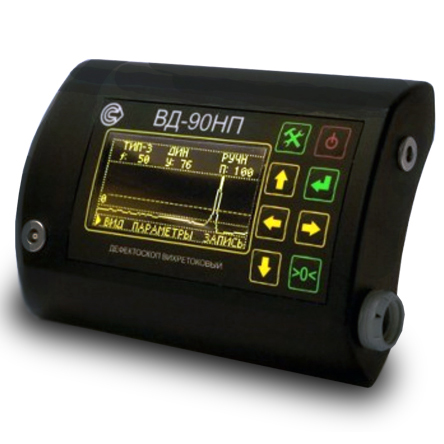Catalog
Search
1059 products
View:
- Selected: 1Applying
- Selected: 0Names
- Selected: 0Manufacturer
- Selected: 0Made in
- Selected: 0Additional
View:
1059 products
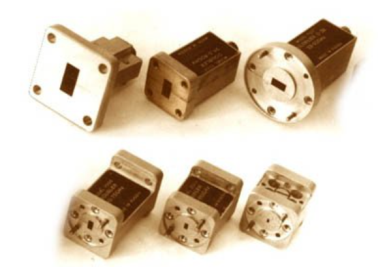
UCHX2-37
Basic properties:
Wide frequency range;
Sufficiently large output power;
High level of suppression of side harmonics of the input signal;
Low value of phase noise;
Relatively simple technical solutions:
- synchronization and frequency stabilization,
- stabilization and adjustment of the output power level,
- implementation of amplitude and frequency modulation modes;
Do not require external bias diodes.
Operating conditions:
Operating temperature range from minus 10 to 50 ° C;
The relative humidity of the air is up to 98% at a temperature of 25 ° C.
Technical characteristics
Input/output frequency range, GHz 12,93-18,75 / 25,86-37,5
Losses (max.), dB 13
Input power level, dBm 15-21
Unevenness of output power (Rvh. = 20 dBm), dB ± 1.5
The level of parasitic harmonics of the input signal at the output (min.), dBn 20
Output VSWR (max.) 2.0
Connector type:
• Input Coax. 3.5/1.5 mm (socket)
• Output Waveguide 7.2x3.4 mm
Overall dimensions, mm 29x24x24
Weight, g 60
TEKHNOYAKS
Moscow
Produced in: Moscow
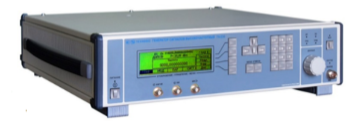
High-frequency signal generator G4-229
The generator is capable of operating both independently and as part of automated measuring systems with USB and IEEE-488 (CPC) interfaces.
Technical specifications
Frequency range (RF output) from 9 kHz to 6 GHz
Frequency range (LF outputs) from 0.001 Hz to 30 MHz
Frequency tuning discreteness (RF output) 1 Hz
Frequency tuning discreteness (LF outputs) 0.001 Hz
The main error of the frequency setting is ± 3x10-7 Hz
The range of setting the output signal power level at the main RF output is from minus 120 to 13 dBm
The range of setting the signal amplitude at a load of 50 ohms (LF outputs) from 0.01 to 5 V
The basic error of setting the reference power level (RF output) ± (0.5 – 1.0) dB
The basic error of setting the amplitude of sinusoidal signals (LF outputs) ± (3 – 15)%
Instability of the signal power level for any 15-minute time interval (RF output) no more than 0.1 dB
Metrological characteristics of the generator in the FM operation mode:
- frequency range of the modulating signal from 1 to 100 kHz
- frequency deviation setting range (taking into account the carrier frequency value) from 12.5 to 4000 kHz
- the basic error of setting the frequency deviation ± (10 – 20)%
Metrological characteristics of the generator in AM operation mode:
- frequency range of the modulating signal from 0.05 to 5.0 kHz
- the range of setting the amplitude modulation coefficient from 1 to 100 %
- the basic error of setting the amplitude modulation coefficient (when operating from an internal signal source) ± (0.15 M + 0.2)%
Metrological characteristics of the generator in the IM operation mode:
- the duration range of modulating pulses from 100 ns to 20 s
- the range of the modulating pulse repetition period from 140 ns to 30 s
- the difference in the duration of the output RF pulses from the duration of the modulating pulses ± 100 ns
Operating temperature range from minus 10 to 40 °C
AC power supply 220 V, 50 Hz
Power consumption, not more than 100 VA
Overall dimensions, mm 498x136x487
Weight, not more than 15 kg
TEKHNOYAKS
Moscow
Produced in: Moscow
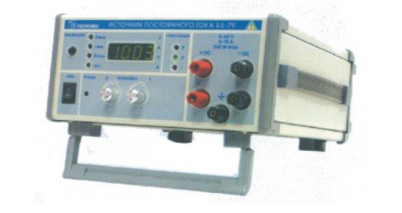
DC power supply B5-79
The B5-79 DC power supply is designed to provide constant voltage and current to measuring instruments and equipment during the development, production, operation and repair of electronic devices.
Technical specifications
Output voltage setting range from 0 to 60 V
Output current setting range from 0.2 to 10 A
Maximum output power 300W
The main error of the output voltage setting is ± 300 mV
The main error of the output current setting is ± 100 mA
Additional error in setting the output voltage caused by a deviation of the mains voltage from the nominal value by ± 10% ± (0.0001 · Uust + 1 mV)
Additional error in setting the output voltage caused by a change in the load current from 0.9 of the maximum value to zero ± (0.0002 · Uust + 5 mV)
Additional error in setting the output current caused by a deviation of the mains voltage from the nominal value by ± 10% ± (0.0002 · Iust + 2 mA)
Additional error in setting the output current caused by a change in the load voltage from 0.9 of the maximum value to zero ± (0.0005 · Iust + 5 mA)
Instability of the output voltage for any 10 minutes during 8 hours of continuous operation, no more than ± 50 mV
Instability of the output current for any 10 minutes during 8 hours of continuous operation, no more than ± 50 mA
Operating temperature range from minus 10 to 50 °C
AC power supply 220 V, 50 Hz
Power consumption, no more than 500 VA
Overall dimensions, mm 240x128x313
Weight, not more than 6.0 kg
TEKHNOYAKS
Moscow
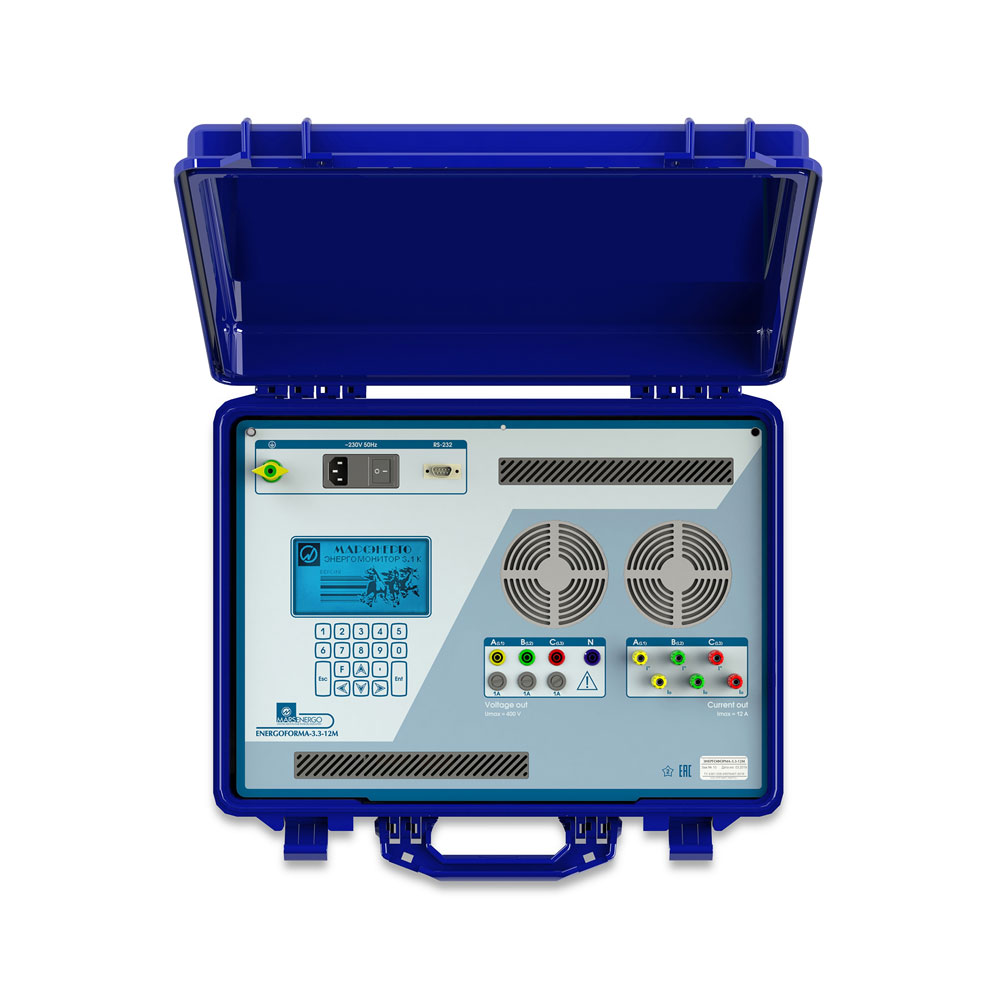
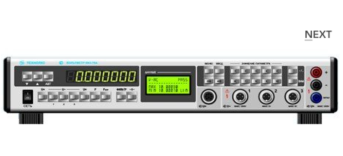
AC voltage voltmeter VK3-78A
The voltmeter is capable of working both independently and as part of automated measuring systems with interfaces such as USB, RS-232, IEEE-488 (CPC).
Technical specifications
Measuring ranges of electrical quantities:
- constant electrical voltage from 3 MV to 1000 V
- SCR of alternating electric voltage in the frequency range from 10 Hz to 1 MHz (AC) from 10 MV to 1000 V
- RF RF AC voltage in the frequency range from 10 Hz to 2000 MHz (RF) from 10 mV to 100 V
- frequency of the measured AC voltage from 10 Hz to 1 MHz
Measurement errors of electrical quantities:
- constant electrical voltage ± (0.0021 - 17)%
- SCR of alternating electric voltage in the frequency range from 10 Hz to 10 MHz (AC) ± (0.017 - 21)%
- RF RF AC voltage in the frequency range from 10 Hz to 2000 MHz (RF) ± (0.21 - 16)%
- frequency of the measured alternating electric voltage ± (0.1 -10.1)%
General characteristics:
Operating temperature range from 5 to 40 °C
AC power supply 220 V, 50 Hz
Power consumption, no more than 50 VA
Overall dimensions, mm 489x91x381
Weight, not more than 8.5 kg
TEKHNOYAKS
Moscow
Produced in: Moscow

UCHX2-78
Basic properties:
Wide frequency range;
Sufficiently large output power;
High level of suppression of side harmonics of the input signal;
Low phase noise value;
Relatively simple technical solutions:
- synchronization and frequency stabilization,
- stabilization and adjustment of the output power level,
- implementation of amplitude and frequency modulation modes;
Do not require external bias diodes.
Operating conditions:
Operating temperature range from minus 10 to 50 ° C;
The relative humidity of the air is up to 98% at a temperature of 25 ° C.
Technical characteristics
Input/output frequency range, GHz 26,78-39,17 / 53,57-78,33
Losses (max.), dB 15
Input power level, dBm 15-21
Unevenness of output power (Rvh. = 20 dBm), dB ± 2.0
The level of parasitic harmonics of the input signal at the output (min.), dBn 20
Output VSWR (max.) 2.0
Connector type:
• Input Coax. 2.4/1.0 mm (plug/socket)
• Output Waveguide 3,759x1,88 mm (50-75GGo)
Overall dimensions, mm 26x20x20
Weight, g 50
TEKHNOYAKS
Moscow
Produced in: Moscow
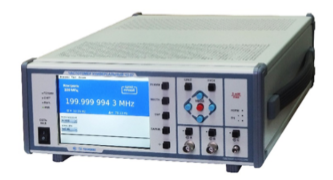
Universal frequency meter Ch3-97
The device successfully combines simplicity of design, modern design, convenience, clarity of control and obtaining information about the measured physical quantity.
Technical specifications
Frequency and period of sinusoidal signals (inputs A, B) 0.001 Hz - 300 MHz
Frequency and period of video pulse signals (inputs A, B) 0.001 Hz - 300 MHz
Frequency of continuous sinusoidal oscillations (input C) (0.3 – 37.5) GHz
Carrier frequency of a continuous radio pulse sequence (IM) signal (input C) Fn = (0.3-37.5) GHz, from 0.3 microseconds to 1ms, Fsl from 100 Hz to 1 MHz, from 2 to 103
Frequency ratio (inputs A, B) from 1 to 3x109
Pulse duration 5 ns - 1000 s
The duration of the front, the decay of the pulses is 5 ns - 100 microseconds
Time interval from -1000 to 1000 s
Phase difference of two synchronous sinusoidal signals from minus 180° to 180°
The measurement error of the phase difference of two synchronous sinusoidal signals is ± 2.3 ° at a signal amplitude of 1 V
Setting range of trigger levels (inputs A, B) from - 2.0 to 2.0 V
The error of setting the trigger levels (inputs A, B) ± 0.01 V
Input signal level:
•for sinusoidal signal (inputs A, B) (0.03 - 10.0) V
•for video pulse signal (inputs A, B) (0.1 - 10.0) V
•for a sinusoidal signal (input C) 0.1 - 5 MW
Input resistance
•Inputs A, B (50±2.5) ohms; (1±0.1) MOm/100 pF
•Input With (50±2.5) ohms
Nominal frequency value of the reference quartz oscillator 10 MHz
Relative error in the frequency of the quartz oscillator, no more than ± 2x10-7 in 24 months
Operating temperature range from minus 10 to 50 °C
AC power supply 220 V, 50 Hz
Power consumption, not more than 100 VA
Overall dimensions, mm 306x129.5x430.6
Weight, not more than 8.5 kg
TEKHNOYAKS
Moscow
Produced in: Moscow

Measuring step attenuator D1-29
The device replaces the devices for checking the attenuators D1-13A and D1-25.
D1-29 is a step attenuator with a range of attenuation from 0 to 110 dB with a step of 10 dB, operating in the frequency range from 0 to 150 MHz.
The device consists of a housing with damping cells and a switch with a counting device. The housing contains coaxial input and output connectors, as well as additional connectors "40 dB" and "80 dB", necessary for the verification of the device.
Technical specifications
Operating frequency range 0 – 150 MHz
Difference attenuation setting range (after 10 dB) 0 – 110 dB
Input electrical resistance to direct current 50 ± 0.1 ohms
The output electrical resistance to direct current when connected to the load input is 50 ± 0.1 ohms 25 ± 0.1 ohms
The main absolute error of the difference attenuation setting relative to the 0 dB mark at direct current ± (0.002 - 0.02) dB
The main absolute error of the difference attenuation setting relative to the 10 dB mark in the frequency range up to 30 MHz ± (0.004 - 0.9) dB
The main absolute error of the difference attenuation setting relative to the 10 dB mark in the frequency range over 30 to 150 MHz ± (0.09 - 3.0) dB
The maximum permissible value of the electrical voltage (DC or AC) at the input of the attenuator 3 In
the operating temperature range from 5 to 40 ° C
Overall dimensions, mm 149x95x149
Weight, not more than 3 kg
TEKHNOYAKS
Moscow
Produced in: Moscow
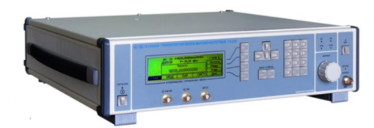
High-frequency signal generator G4-230
The generator is capable of operating both autonomously and as part of automated measuring systems with USB and IEEE-488 (CPC) interfaces.
Technical specifications
Frequency range from 5 to 17.85 GHz
Frequency tuning discreteness 0.001 Hz
The main error of the frequency setting is ± 3x10-7 Hz
The range of setting the output signal power level at the main output is from minus 110 to 13 dBm
The basic error of setting the reference power level is ± 1.0 dB
Instability of the output signal power level for any 15-minute time interval of no more than 0.1 dB
Metrological characteristics of the generator in the FM operation mode:
- frequency range of the modulating signal:
low frequency from 1 Hz to 20 kHz
RFM from 10 to 100 kHz
- frequency deviation setting range (taking into account the carrier frequency value):
low frequency from 1 Hz to 100 kHz
RFM from 50 to 10000 kHz
- the main error of the frequency deviation setting is ± (3 – 18)%
Metrological characteristics of the generator in AM operation mode:
- frequency range of the modulating signal from 0.05 to 5.0 kHz
- the range of setting the amplitude modulation coefficient from 1 to 50 %
- the main error in setting the amplitude modulation coefficient:
Internal ± (0.15M + 0.2)%
External ± (0.20M + 0.5)%
Metrological characteristics of the generator in the IM operation mode:
- the duration range of modulating pulses from 100 ns to 20 s
- the range of the modulating pulse repetition period from 140 ns to 30 s
- the difference in the duration of the output RF pulses from the duration of the modulating pulses ± 100 ns
Operating temperature range from minus 10 to 40 °C
AC power supply 220 V, 50 Hz
Power consumption, no more than 150 VA
Overall dimensions, mm 498x136x487
Weight, not more than 15 kg
TEKHNOYAKS
Moscow
Produced in: Moscow
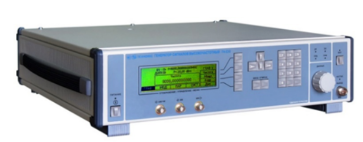
High-frequency signal generator G4-227
The generator is capable of operating both independently and as part of automated measuring systems with USB and IEEE-488 (CPC) interfaces.
Technical specifications
Frequency range from 9 kHz to 6 GHz
Frequency tuning discreteness of 1 Hz
The main error of the frequency setting is ± 3x10-7 Hz
The range of setting the output signal power level at the main output is from minus 10 to 13 dBm
The basic error of setting the reference power level is ± (0.5 – 1.0) dB
Instability of the output signal power level for any 15-minute time interval of no more than 0.1 dB
Metrological characteristics of the generator in the FM operation mode:
- frequency range of the modulating signal from 1 to 100 kHz
- frequency deviation setting range (taking into account the carrier frequency value) from 12.5 to 4000 kHz
- the main error of the frequency deviation setting is ± (20 – 25)%
Metrological characteristics of the generator in AM operation mode:
- frequency range of the modulating signal from 0.05 to 5.0 kHz
- the range of setting the amplitude modulation coefficient from 1 to 100 %
- the basic error of setting the amplitude modulation coefficient ± (0.25 M + 0.2)%
Metrological characteristics of the generator in the IM operation mode:
- the duration range of modulating pulses from 300 ns to 20 s
- the range of the modulating pulse repetition period from 340 ns to 30 s
- the difference in the duration of the output RF pulses from the duration of the modulating pulses ± 200 ns
Operating temperature range from minus 10 to 40 °C
AC power supply 220 V, 50 Hz
Power consumption, not more than 100 VA
Overall dimensions, mm 498x136x487
Weight, not more than 13 kg
TEKHNOYAKS
Moscow
Produced in: Moscow

Universal voltmeter V7-81
The voltmeter is capable of operating both independently and as part of automated measuring systems with RS-232 type interfaces.
Technical specifications
Ranges of measurement of electrical quantities:
- constant electrical voltage from 10 MV to 1000 V
- SCR of alternating electric voltage in the frequency range from 10 Hz to 10 MHz (AC) from 1 mV to 750 V
- DC current from 0.1 µA to 20 A
- SCR of alternating electric current in the frequency range from 10 Hz to 5 kHz from 10 µA to 20 A
- electrical resistance from 10 mOhm to 1 GOm
- frequency of the measured alternating electric voltage from 10 Hz to 1 MHz
Measurement errors of electrical quantities:
- constant electrical voltage ± (0.0028 - 20)%
- SCR of alternating electric voltage in the frequency range from 10 Hz to 10 MHz (AC) ± (0.09 - 15)%
- DC power ± (0.012 - 20)%
- SCR of alternating electric current in the frequency range from 10 Hz to 5 kHz ± (0.11 - 2.35) %
- electrical resistance ± (0.007 - 5.5)%
- frequency of the measured alternating electric voltage ± (0.1 -10.1)%
General characteristics:
Operating temperature range from 5 to 40 °C
AC power supply 220 V, 50 Hz
Power consumption, no more than 20 VA
Overall dimensions, mm 291x110x308
Weight, not more than 4.5 kg
TEKHNOYAKS
Moscow
Produced in: Moscow
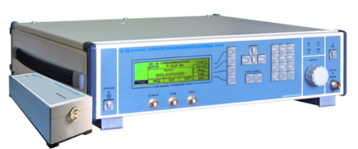
High-frequency signal generator G4-235, G4-236
Created on the basis of the G4-230 generator. Remote frequency converters extend the frequency ranges up to 53.57 GHz (G4-235) and up to 78.33 GHz (G4-236).
The generators are capable of operating both independently and as part of automated measuring systems with USB and IEEE-488 (CPC) interfaces.
Technical specifications
The frequency range at the output of the base unit is from 5 to 20 GHz
Frequency range at the output of the frequency converter (G4-235) from 37.5 to 53.57 GHz
The frequency range at the output of the frequency converter (G4-236) is from 53.57 to 78.33 GHz
Frequency tuning discreteness 0.001 Hz
The main error of the frequency setting is ± 3x10-7 Hz
The range of setting the signal power level at the output of the base unit is from minus 110 to 13 dBm
The range of setting the signal power level at the output of the frequency converter (G4-235) is from 0 to 13 dBm
The range of setting the signal power level at the output of the frequency converter (G4-236) from 0 to 10 dBm
The basic error of setting the reference power level is ± (1.0 – 2.5) dB
Metrological characteristics of the generator in FM operation mode:
- frequency range of the modulating signal from 1 Hz to 20 kHz
- frequency deviation setting range (taking into account the carrier frequency value) from 1 Hz to 200 kHz
- the main error of the frequency deviation setting is ± (5 – 18)%
Metrological characteristics of the generator in AM operation mode:
- frequency range of the modulating signal from 0.05 to 5.0 kHz
- the range of setting the amplitude modulation coefficient from 1 to 50 %
- the basic error of setting the amplitude modulation coefficient ± (0.15 M + 0.2)%
Metrological characteristics of the generator in the IM operation mode:
- the duration range of modulating pulses from 100 ns to 20 s
- the range of the modulating pulse repetition period from 140 ns to 30 s
- the difference in the duration of the output RF pulses from the duration of the modulating pulses ± 100 ns
Operating temperature range from 5°C to 40 °C
AC power supply 220 V, 50 Hz
Power consumption, no more than 150 VA
Overall dimensions, mm 498x136x487
Weight, not more than 20 kg
TEKHNOYAKS
Moscow
Produced in: Moscow
